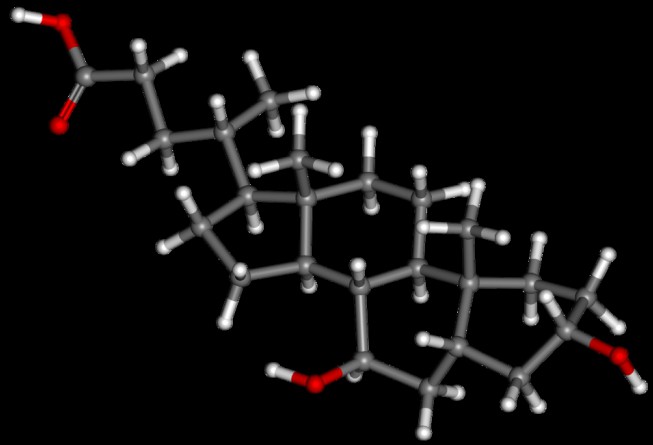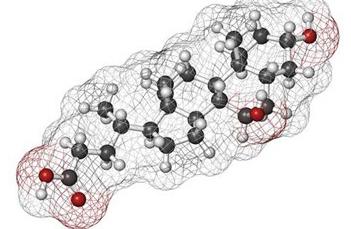Recently, for the treatment of various liver lesions, ursodeoxycholic acid is increasingly being used. Instructions for use of this chemical compound indicate its effectiveness in many serious diseases. What is this substance? What is ursodeoxycholic acid intended for? In which products is it present?
Description
Ursodeoxycholic acid, the use of which is based on its origin and properties, is a white-yellow crystalline powder. It has a bitter taste. This substance in a normally functioning human body is produced in small quantities. Its specific gravity is approximately 5% of the total mass of bile acids. It is hydrophilic and does not exhibit cytotoxicity. This chemical compound is soluble in alcohol and acetic glacial acid, slightly soluble in chloroform and practically insoluble in water. Ursodeoxycholic acid is not contained in the products. It is found in the gallbladder of a brown bear.
Ursodeoxycholic acid (UDCA) is an epimer of chenodeoxycholic acid. Initially, it began to be used for the treatment of reflux gastritis and splitting of gallstones. Over time, it began to be used for many other diseases. UDCA is considered the safest bile acid.
The action of ursodeoxycholic acid
To date, the use of UDCA is the standard therapy for various cholestatic liver diseases with an autoimmune component. The mechanism of action of this tool is to stabilize the cells of this organ. Its molecules can integrate into the membranes of the liver cells - hepatocytes. Due to this, they are able to make them more resistant to aggressive factors. This hepatoprotective agent has a choleretic effect. UDCA reduces the synthesis of cholesterol in the liver and prevents its absorption in the intestine. This drug reduces the lithogenicity of bile and increases the acid content in it. It improves lipase activity, pancreatic and gastric secretion. Ursodeoxycholic acid also has a hypoglycemic effect, stimulates the formation and separation of bile, and lowers cholesterol in it.

This drug favors partial or complete cleavage of cholesterol stones. That is why it is used more and more often. Combining with cholesterol, it increases the solubility of its crystals, which acts destructively on gallstones. UDCA has an immunomodulatory effect, which consists in increasing the activity of lymphocytes, reduces the expression of various antigens on the membranes of hepatocytes. It affects the number of T-lymphocytes, reduces the number of eosinophils.

UDCA reduces the concentration of cholesterol in bile by its dispersion and the transition of this substance into the liquid crystalline phase. It affects the enterohepatic circulation of bile salts. As a result of this, reabsorption of endogenous hydrophobic and toxic compounds in the intestine is reduced. This medicine has a direct hepatoprotective and choleretic effect. Ursodeoxycholic acid, reviews of which from specialists in the field of hepatology indicate its effectiveness, can reduce liver fibrosis during its fatty degeneration.
Application
Ursodeoxycholic acid, the use of which is carried out under the supervision of a physician, is prescribed for such pathological conditions:
• the presence of cholesterol stones localized in the gallbladder or common duct;
• the impossibility of treatment with an endoscopic or surgical method;
• chronic, atypical, acute and autoimmune hepatitis ;
• the presence of cholesterol stones after mechanical and extracorporeal lithotripsy;
• toxic (drug, alcohol) liver damage;
• sclerosing cholangitis;
• primary biliary cirrhosis without signs of decompensation;
• atresia of the biliary tract;
• cystic fibrosis;
• chronic active hepatitis;
• cholestasis with parenteral nutrition;
• biliary dyskinesia;
• biliary dyspeptic syndrome with biliary dyskinesia and cholecystopathy;
• chronic opisthorchiasis;
• congenital atresia of the bile ducts;
• biliary reflux esophagitis and reflux gastritis.
Ursodeoxycholic acid (UDCA) is also used to prevent liver damage caused by taking cytostatics and hormonal contraceptives. It is prescribed for other diseases caused by stagnation of bile. UDCA is also prescribed for adjunctive treatment for transplantation of the liver or other organs.
Contraindications
Ursodeoxycholic acid, reviews of which are mostly positive, has serious contraindications. These include:
• inflammatory diseases of the gallbladder, intestines and bile ducts in the acute phase;
• high calcium X-ray gallstones;
• obstruction of the biliary tract;
• hypersensitivity;
• cirrhosis of the liver during decompensation;
• Crohn's disease;
• pronounced disorders in the functioning of the pancreas, liver and kidneys.
Usage restrictions
Ursodeoxycholic acid, the instructions for use of which clearly indicates the absence of strict restrictions on its use, is not prescribed for babies under 3 years in capsule form. For their treatment, suspensions containing this medicinal substance are used. So far, specialists have not conducted relevant studies aimed at determining the cholelitolytic effect of this substance depending on the age of the child. At the same time, studies conducted on children with atresia of the bile ducts and some liver diseases did not show specific pediatric problems.
Preparations containing ursodeoxycholic acid are prescribed for pregnant women only when the expected effect of therapy with this drug exceeds the potential risk for the unborn child. At the same time, do not forget that no one has carried out full-fledged scientific research on the safety of this substance for this category of patients. Since it is not known for certain whether UDCA passes into breast milk, caution is required in prescribing this drug to lactating women.
Side effects
Ursodeoxycholic acid, the instructions for use of which indicate not only limitations in its use, but also possible side effects, can lead to pathological phenomena such as:
• constipation, diarrhea;
• nausea;
• increased activity of transaminases;
• pain in the right hypochondrium and epigastric region;
• allergic reactions to the skin (itching, rash);
• calcination of stones.
Treatment of primary biliary cirrhosis with this drug sometimes leads to the patient experiencing transient decompensation, which disappears after discontinuation of this drug.
Precautionary measures
For successful litholysis of cholesterol stones using UDC, the following conditions must be considered:
• their size does not exceed 2 cm;
• they do not give a shadow on the roentgenogram;
• the gallbladder is functioning normally;
• ducts maintain patency;
• the bubble is filled with stones less than half;
• the common bile duct does not contain stones.
What other restrictions in reception has ursodeoxycholic acid? The instructions for this medication indicate that with prolonged treatment that exceeds 1 month, it is necessary to regularly monitor (1 time in 30 days) liver transaminases, phosphatase, bilirubin, gamma-glutamyl transferase. Conducting such analyzes is especially important in the initial 3 months of therapy using UDCA. The effectiveness of treatment is confirmed once every six months by X-ray and ultrasound examination of bile ducts. To prevent attacks of relapses of cholelithiasis, treatment is continued even after the stones are completely dissolved. It can last for many months.
During treatment of UDCF, women of childbearing age are advised to use reliable methods of preventing pregnancy. It can be non-hormonal drugs or contraceptives with a low estrogen content.
Release form and dosage
Ursodeoxycholic acid, the instructions for use of which give a detailed description of its administration, is available in the following dosage forms:
• capsules and tablets of 150 and 250 mg;
• suspension for children.
The dosage of ursodeoxycholic acid is set strictly individually. It depends on the severity of the person’s condition and his body weight. Most often, it is prescribed at 10-20 mg / kg per day. This dose is taken at a time, in the evening. The duration of therapy depends on the indications. This medicine is absorbed in the small intestine, and after 3 hours in the blood plasma its highest concentration is noted. The constant use of medicines containing ursodeoxycholic acid makes it the main bile acid in the human body. This substance undergoes a number of transformations and is ultimately excreted in the form of metabolites with feces and urine.
The duration of therapy is determined by the attending physician. It may be different depending on the type of disease. In some particularly severe cases, UDCA preparations last for years.
Interaction with other drugs
When combined with UDCA and Cyclosporine, the absorption of the latter increases unpredictably. At the same time, the concentration of these drugs sharply increases in blood plasma. In rare cases, UDCA is taken concomitantly with Ciprofloxacin, the concentration of the latter decreases.
Ursodeoxycholic acid (analogues)
Ursodeoxycholic acid (capsules, tablets) is available under various names. Such funds differ among themselves with the auxiliary substances that make up their composition. So, on sale you can find the following drugs with ursodeoxycholic acid:
• Ursosan capsules, which are prescribed for the treatment of diffuse liver diseases, cholelithiasis, with biliary reflux gastritis and reflux esophagitis, primary cirrhosis, drug and toxic liver lesions, cholecystectomy, alcoholic disease, sclerosing cholangitis, non-biliary duct atresia. Ursodeoxycholic acid (Ursosan) is also used to prevent liver damage.
• Ukrliv tablets, which are taken for liver failure, chronic hepatitis, cholelithiasis.
• Ursofalk capsules, prescribed for various
diseases of the gallbladder and liver, accompanied by cholestasis, a decrease in some liver functions, and an increase in cholesterol. These include: primary biliary cirrhosis and
sclerosing cholangitis, reflux gastritis and reflux esophagitis, hepatitis of various etiologies, cholesterol stones, cystic fibrosis, various liver lesions, stagnation of bile. This drug is used as a prophylactic against liver damage when taking potent drugs.
• Ursodex tablets, which are taken with biliary cirrhosis without signs of decompensation and reflux gastritis. They are used to dissolve small cholesterol stones during the normal functioning of the gallbladder.
• Ursodez capsules, used for splitting cholesterol stones, treating reflux gastritis, for symptomatic therapy for primary cirrhosis without signs of decompensation.
• Ursolysin Capsules, prescribed for the dissolution of cholesterol stones and symptomatic treatment of biliary cirrhosis, gallbladder cholesterosis and reflux gastritis. The drug is used in complex therapy for the treatment of patients with chronic hepatitis and cirrhosis.
• Capsules "Choludexan" used to treat uncomplicated cholelithiasis, chronic active hepatitis, alcohol and toxic liver damage, non-alcoholic steatohepatitis, primary biliary cirrhosis, primary sclerosing cholangitis, cystic fibrosis, biliary dyskinesia, reflux reflux, and reflux reflux
• Urdox capsules, which are prescribed for primary biliary cirrhosis without signs of decompensation, reflux gastritis. The drug dissolves well small and medium cholesterol stones while maintaining the normal function of the gallbladder.
• Ursorom C capsules prescribed for uncomplicated cholelithiasis, primary liver cirrhosis, acute and chronic hepatitis, sclerosing cholangitis, intrahepatic atresia, reflux gastritis and reflux esophagitis, cholestasis, with parenteral nutrition, liver dyskinesia, cystic fibrosis, fatty hepatosis, dyspeptic syndrome. The drug is also used to prevent liver damage when using hormonal contraceptives and cytostatics, the formation of stones in obesity.
Ursodeoxycholic acid, analogues of this substance are taken only as directed by the attending physician.